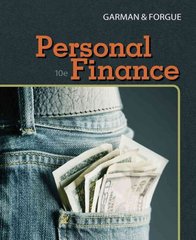Question
The file CarDemand_2020.XLS contains data through 1990 on new car sales and other economic variables. The variables are: Domestic auto sales (Sales) in thousands, Real
The file CarDemand_2020.XLS contains data through 1990 on new car sales and other economic variables. The variables are: Domestic auto sales (Sales) in thousands, Real price index for new cars (RP) where 1967=100 in the base year), Real disposable income (RDI) in 1982 dollars, Interest rate (IR).
5. What is your estimate of the price elasticity of demand (RP), income elasticity of demand (RDI), and cross price elasticity of demand (IR) in the multiplicative model? Compare these elasticity estimates with the corresponding elasticities in the linear model when calculated at mean values for each variable.
6. In the multiplicative model perform a statistical test to determine whether demand is elastic, interest rates are a complement good, and if new car sales are a normal good at the 95 percent confidence level.
7. During a year in which the real price index is 250, the interest rate is 12, and real disposable income per capita is $3500 what is your forecast for new car sales using the multiplicative model? Derive a 95 percent confidence interval around this forecast.
8. Use the demand elasticities from your multiplicative model to analyze the following policies designed to increase new car sales:
a) If the Federal Reserve lowers interest rates from 4 to 2.5 how will this affect car sales in percentage terms?
b) If simulative fiscal policy in U. S. increases per capita income by 5 percent how will this affect car sales in percentage terms?
Extra Credit (up to 5 points): Given your forecast above there is a 10 percent chance that car sales will be less than or equal to what level? (Hint: Use the standard error of the forecast and the fact that the errors are approximately normally distributed).
| Car demand data | ||||
| Year | Quantity | Price | Income | Interest |
| 1970 | 7,115,270 | 107.6 | 1668.1 | 7.91% |
| 1971 | 8,676,410 | 112 | 1728.4 | 5.72% |
| 1972 | 9,321,310 | 111 | 1797.4 | 5.25% |
| 1973 | 9,618,510 | 111.1 | 1916.3 | 8.03% |
| 1974 | 7,448,340 | 117.5 | 1896.6 | 10.81% |
| 1975 | 7,049,840 | 127.6 | 1931.7 | 7.86% |
| 1976 | 8,606,860 | 135.7 | 2001 | 6.84% |
| 1977 | 9,104,930 | 142.9 | 2066.6 | 6.83% |
| 1978 | 9,304,250 | 153.8 | 2167.4 | 9.06% |
| 1979 | 8,316,020 | 166 | 2212.6 | 12.67% |
| 1980 | 6,578,360 | 179.3 | 2214.3 | 15.27% |
| 1981 | 6,206,690 | 190.2 | 2248.6 | 18.87% |
| 1982 | 5,756,610 | 197.6 | 2261.5 | 14.86% |
| 1983 | 6,795,230 | 202.6 | 2331.9 | 10.79% |
| 1984 | 7,951,790 | 208.5 | 2469.8 | 12.04% |
| 1985 | 8,204,690 | 215.2 | 2542.2 | 9.93% |
| 1986 | 8,222,480 | 224.4 | 2645.1 | 8.33% |
| 1987 | 7,080,890 | 232.5 | 2676.1 | 8.22% |
| 1988 | 7,845,000 | 243 | 2690.1 | 8.21% |
| 1989 | 7,932,255 | 247.4 | 2700.4 | 8.34% |
| 1990 | 8,997,579 | 240.5 | 2650 | 8.47% |
Step by Step Solution
There are 3 Steps involved in it
Step: 1

Get Instant Access to Expert-Tailored Solutions
See step-by-step solutions with expert insights and AI powered tools for academic success
Step: 2

Step: 3

Ace Your Homework with AI
Get the answers you need in no time with our AI-driven, step-by-step assistance
Get Started


